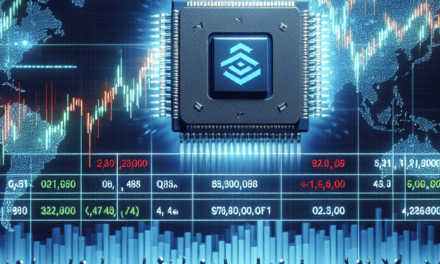“RTX Stock Soars to New Heights: Can It Reach the Summit Again?”
Introduction
In October 2023, RTX Corporation (formerly Raytheon Technologies) achieved a significant milestone by reaching an all-time high in its stock price, reflecting strong investor confidence and robust financial performance. This surge can be attributed to a combination of factors, including increased defense spending, advancements in aerospace technology, and strategic partnerships that have bolstered the company’s market position. As analysts and investors assess the sustainability of this upward trajectory, questions arise about whether RTX can replicate this success in the future. With ongoing developments in the defense sector and a focus on innovation, the potential for RTX to reach new heights remains a topic of keen interest among market watchers.
RTX Stock Performance Analysis
In October, RTX stock achieved an all-time high, marking a significant milestone for the company and its investors. This remarkable performance can be attributed to a combination of factors, including strong financial results, strategic initiatives, and favorable market conditions. As investors reflect on this achievement, it is essential to analyze the underlying elements that contributed to this surge and consider whether RTX can replicate this success in the future.
To begin with, the financial performance of RTX has been robust, with the company consistently reporting impressive earnings and revenue growth. The latest quarterly results showcased a substantial increase in both metrics, driven by heightened demand for its advanced technologies and products. This growth trajectory has not only bolstered investor confidence but has also attracted the attention of analysts who have revised their price targets upward. Consequently, the positive sentiment surrounding RTX stock has been palpable, leading to increased buying activity and, ultimately, the stock’s ascent to new heights.
Moreover, RTX has been proactive in implementing strategic initiatives aimed at enhancing operational efficiency and expanding its market presence. The company’s focus on innovation, particularly in the aerospace and defense sectors, has positioned it favorably in a competitive landscape. By investing in research and development, RTX has been able to introduce cutting-edge solutions that meet the evolving needs of its customers. This commitment to innovation not only strengthens its product offerings but also reinforces its reputation as a leader in the industry, further driving investor interest.
In addition to these internal factors, external market conditions have played a crucial role in RTX’s stock performance. The broader economic environment has been characterized by a recovery from the pandemic, with increased spending in defense and aerospace sectors. Government contracts and defense budgets have seen upward revisions, providing a favorable backdrop for RTX’s growth. As a result, the company has been well-positioned to capitalize on these trends, which has contributed to the stock’s impressive rally.
However, as investors look ahead, it is essential to consider the potential challenges that could impact RTX’s ability to sustain its all-time high. Market volatility, geopolitical tensions, and supply chain disruptions are factors that could pose risks to the company’s performance. Additionally, while the current demand for aerospace and defense products is strong, any shifts in government spending priorities or economic downturns could adversely affect RTX’s growth prospects. Therefore, it is crucial for investors to remain vigilant and assess these risks as they evaluate the stock’s future trajectory.
Despite these challenges, the overall outlook for RTX remains positive. The company’s strong fundamentals, commitment to innovation, and strategic positioning in a growing market suggest that it has the potential to continue delivering value to its shareholders. As the company navigates the complexities of the market, its ability to adapt and respond to changing conditions will be critical in determining whether it can replicate its recent success.
In conclusion, while RTX stock has reached an all-time high in October, the question of whether it can repeat this feat hinges on a multitude of factors. By analyzing its financial performance, strategic initiatives, and market conditions, investors can gain valuable insights into the company’s potential for future growth. As always, a careful assessment of risks and opportunities will be essential for making informed investment decisions in the dynamic landscape that lies ahead.
Historical Trends of RTX Stock
In October 2023, RTX stock achieved an all-time high, marking a significant milestone in the company’s financial trajectory. To understand the implications of this achievement, it is essential to examine the historical trends of RTX stock, which can provide valuable insights into its performance and potential future movements. Historically, RTX, formerly known as Raytheon Technologies, has demonstrated resilience and adaptability in a rapidly changing market landscape. This adaptability has been particularly evident in the defense and aerospace sectors, where the company has maintained a strong foothold.
Looking back, the stock has experienced various fluctuations influenced by both macroeconomic factors and company-specific developments. For instance, during periods of heightened geopolitical tensions, RTX stock often saw an uptick, reflecting increased government spending on defense. Conversely, during economic downturns, the stock faced challenges, as budget constraints typically led to reduced defense expenditures. This cyclical nature of the defense industry underscores the importance of external factors in shaping stock performance.
Moreover, the company’s strategic mergers and acquisitions have played a pivotal role in its historical stock performance. The merger between Raytheon and United Technologies in 2020 created a diversified aerospace and defense powerhouse, which has since bolstered RTX’s market position. This consolidation not only enhanced operational efficiencies but also expanded the company’s product offerings, thereby attracting a broader investor base. As a result, the stock has generally trended upward since the merger, reflecting investor confidence in the company’s long-term growth prospects.
In addition to strategic decisions, technological advancements have also influenced RTX stock trends. The company has consistently invested in research and development, leading to innovations in areas such as hypersonics, advanced missile systems, and next-generation aircraft. These advancements not only enhance the company’s competitive edge but also align with the increasing demand for sophisticated defense solutions. Consequently, as RTX continues to innovate, it is likely to maintain investor interest, which could positively impact stock performance.
Furthermore, the broader economic environment has historically played a crucial role in shaping RTX stock trends. Interest rates, inflation, and overall market sentiment can significantly influence investor behavior. For instance, during periods of low interest rates, investors often seek equities as a more attractive investment option compared to fixed-income securities. This shift can lead to increased demand for stocks like RTX, particularly when the company demonstrates strong fundamentals and growth potential.
As we analyze the recent all-time high reached by RTX stock in October 2023, it is essential to consider these historical trends. The stock’s performance has been characterized by resilience in the face of challenges, strategic growth initiatives, and a commitment to innovation. However, the question remains: will RTX stock repeat this feat? While historical performance can provide a framework for understanding potential future movements, it is crucial to remain cognizant of the ever-evolving market dynamics. Factors such as changes in government defense budgets, global geopolitical developments, and economic conditions will undoubtedly play a role in determining the stock’s trajectory.
In conclusion, the historical trends of RTX stock reveal a complex interplay of various factors that have shaped its performance over time. As the company continues to navigate the challenges and opportunities within the defense and aerospace sectors, investors will be keenly watching to see if RTX can sustain its momentum and achieve new heights in the future.
Factors Influencing RTX Stock Price
In October, RTX stock reached an all-time high, a milestone that has sparked considerable interest among investors and analysts alike. Understanding the factors influencing RTX’s stock price is essential for those looking to gauge whether this achievement can be replicated in the future. Several elements contribute to the fluctuations in RTX’s stock value, including market conditions, company performance, and broader economic indicators.
One of the primary factors affecting RTX stock is the overall performance of the aerospace and defense sector. As a major player in this industry, RTX is significantly influenced by government spending on defense and aerospace projects. When defense budgets increase, companies like RTX often see a corresponding rise in demand for their products and services. Conversely, any cuts to defense spending can lead to a decline in stock prices. Therefore, investors closely monitor government policies and budget proposals, as these can have immediate and profound effects on RTX’s financial outlook.
In addition to government spending, technological advancements play a crucial role in shaping RTX’s stock price. The company is known for its commitment to innovation, particularly in areas such as aerospace technology and defense systems. As RTX continues to develop cutting-edge products, it enhances its competitive edge, which can lead to increased sales and higher stock valuations. For instance, advancements in hypersonic technology or next-generation aircraft can attract significant attention from both investors and customers, potentially driving the stock price upward.
Moreover, the global economic environment also influences RTX’s stock performance. Economic indicators such as GDP growth, unemployment rates, and consumer confidence can impact investor sentiment and, consequently, stock prices. A robust economy typically leads to increased demand for air travel and defense services, which can benefit RTX. Conversely, economic downturns can result in reduced spending on both commercial and defense-related projects, negatively affecting the stock price. Therefore, investors must remain vigilant about macroeconomic trends and their potential implications for RTX.
Another critical factor is the company’s financial health, which is reflected in its earnings reports and guidance. Strong quarterly earnings can bolster investor confidence and lead to stock price appreciation. Conversely, disappointing earnings or lowered guidance can trigger sell-offs. Investors often scrutinize key performance indicators such as revenue growth, profit margins, and cash flow to assess RTX’s financial stability. Additionally, any announcements regarding mergers, acquisitions, or partnerships can significantly impact stock prices, as they may signal future growth opportunities or risks.
Furthermore, geopolitical factors cannot be overlooked when considering RTX’s stock price. The company operates in a global market, and international relations can have a direct impact on its operations. For instance, tensions between countries may lead to increased defense spending, benefiting RTX. On the other hand, trade disputes or sanctions can disrupt supply chains and affect profitability. Therefore, investors must stay informed about geopolitical developments and their potential ramifications for RTX.
In conclusion, the factors influencing RTX stock price are multifaceted and interconnected. From government spending and technological advancements to economic conditions and geopolitical dynamics, each element plays a vital role in shaping investor perceptions and stock performance. As RTX continues to navigate these complexities, the question remains whether it can replicate its recent success and reach new heights in the future. Investors will undoubtedly be watching closely, eager to see how these various factors unfold in the coming months.
Expert Predictions for RTX Stock
In October, RTX stock reached an all-time high, a milestone that has sparked considerable interest among investors and analysts alike. As the market continues to evolve, many are left wondering whether this remarkable achievement can be replicated in the near future. Expert predictions regarding RTX stock are varied, reflecting a range of factors that could influence its trajectory. Analysts are closely monitoring the company’s performance, particularly in light of its recent advancements and strategic initiatives.
One of the primary drivers of RTX’s stock performance is its commitment to innovation and technological advancement. The company has made significant investments in research and development, particularly in the aerospace and defense sectors. This focus on cutting-edge technology positions RTX favorably in a competitive market, as demand for advanced systems and solutions continues to grow. Experts suggest that if RTX can maintain its momentum in innovation, it may very well sustain its stock price at elevated levels.
Moreover, the geopolitical landscape plays a crucial role in shaping the future of RTX stock. With increasing global tensions and a heightened emphasis on national security, defense spending is expected to rise. Analysts predict that this trend could benefit RTX, as governments allocate more resources to modernizing their military capabilities. Consequently, if RTX can secure lucrative contracts and partnerships, it may bolster investor confidence and drive the stock price higher.
In addition to external factors, the company’s financial health is a critical consideration for experts assessing RTX stock. Recent earnings reports have shown promising growth, with revenue and profit margins exceeding expectations. This positive financial performance has led to increased optimism among investors, who are keen to capitalize on the stock’s upward trajectory. However, some analysts caution that market volatility and economic uncertainties could pose risks to RTX’s continued success. Therefore, it is essential for investors to remain vigilant and consider both the potential rewards and risks associated with the stock.
Furthermore, the broader market conditions will undoubtedly influence RTX’s stock performance. As interest rates fluctuate and inflation concerns persist, investors are likely to reassess their portfolios. In this context, RTX’s ability to adapt to changing economic conditions will be paramount. Experts emphasize the importance of monitoring macroeconomic indicators, as these factors can significantly impact investor sentiment and stock valuations.
Looking ahead, many analysts express a cautiously optimistic outlook for RTX stock. While the company has demonstrated resilience and adaptability, the path to sustained growth is not without challenges. Experts recommend that investors keep a close eye on upcoming earnings reports and industry developments, as these will provide valuable insights into the company’s future prospects. Additionally, the potential for strategic acquisitions or partnerships could further enhance RTX’s market position, making it an attractive option for long-term investors.
In conclusion, while RTX stock has reached an all-time high, the question of whether it can repeat this feat remains open to interpretation. Expert predictions highlight a combination of factors, including innovation, geopolitical dynamics, financial health, and broader market conditions, all of which will play a pivotal role in shaping the stock’s future. As investors navigate this complex landscape, staying informed and adaptable will be essential in making sound investment decisions regarding RTX stock.
Comparison with Competitors’ Stock Performance
In October, RTX stock achieved an all-time high, a remarkable milestone that has drawn attention not only from investors but also from analysts keen to understand the underlying factors contributing to this surge. To fully appreciate RTX’s performance, it is essential to compare it with the stock performance of its primary competitors in the aerospace and defense sectors. This comparative analysis provides valuable insights into market dynamics and the potential for RTX to replicate its recent success.
When examining the stock performance of RTX, it is crucial to consider the broader context of the aerospace and defense industry. Major competitors such as Boeing and Lockheed Martin have also experienced fluctuations in their stock prices, influenced by various factors including government contracts, supply chain challenges, and geopolitical tensions. For instance, Boeing has faced significant hurdles in recent years, including production delays and regulatory scrutiny, which have adversely affected its stock performance. In contrast, RTX has managed to navigate these challenges more effectively, leading to a more favorable market perception and, consequently, a stronger stock price.
Moreover, Lockheed Martin, while maintaining a robust position in the defense sector, has seen its stock performance impacted by shifts in defense spending and budget allocations. The company’s reliance on government contracts makes it particularly sensitive to changes in political priorities. In contrast, RTX has diversified its portfolio, engaging in both commercial and defense sectors, which has provided a buffer against market volatility. This strategic positioning has allowed RTX to capitalize on growth opportunities, particularly in emerging technologies such as hypersonics and advanced avionics, further enhancing its competitive edge.
Additionally, the recent surge in RTX’s stock can be attributed to positive earnings reports and optimistic forecasts from analysts. The company has demonstrated strong revenue growth, driven by increased demand for its products and services. This growth trajectory stands in stark contrast to some of its competitors, who have struggled to maintain consistent earnings amid economic uncertainties. As a result, investors have shown a greater willingness to invest in RTX, bolstered by the company’s solid fundamentals and growth potential.
Furthermore, the overall market sentiment towards the aerospace and defense sectors has shifted in recent months, with increased focus on national security and defense capabilities. This shift has created a favorable environment for companies like RTX, which are well-positioned to benefit from rising defense budgets and increased government spending. In this context, RTX’s stock performance can be seen as a reflection of broader industry trends, as well as the company’s ability to adapt and innovate in a rapidly changing landscape.
As investors look ahead, the question remains whether RTX can sustain its momentum and reach new heights in the coming months. While the company has demonstrated resilience and adaptability, it is essential to remain cognizant of the competitive landscape. The performance of competitors like Boeing and Lockheed Martin will undoubtedly influence market dynamics, and any significant developments within these companies could impact RTX’s stock trajectory. Nevertheless, the combination of RTX’s strategic positioning, strong financial performance, and favorable market conditions suggests that the company is well-equipped to navigate potential challenges and continue its upward trajectory. Ultimately, while past performance is not always indicative of future results, the current landscape presents a promising outlook for RTX as it seeks to build on its recent achievements.
Impact of Market Conditions on RTX Stock
In October, RTX stock achieved an all-time high, a milestone that has sparked considerable interest among investors and analysts alike. Understanding the impact of market conditions on RTX stock is crucial for evaluating whether this remarkable performance can be replicated in the future. Various factors, including economic indicators, industry trends, and geopolitical events, play a significant role in shaping the stock’s trajectory.
To begin with, the broader economic environment is a primary determinant of stock performance. In recent months, the U.S. economy has shown signs of resilience, characterized by steady job growth and consumer spending. These positive indicators have bolstered investor confidence, leading to increased demand for stocks across various sectors, including aerospace and defense, where RTX operates. As a result, the favorable economic climate has contributed to the upward momentum of RTX stock, allowing it to reach unprecedented heights.
Moreover, industry-specific trends have also influenced RTX’s stock performance. The aerospace and defense sectors have experienced a resurgence, driven by heightened global security concerns and increased government spending on defense. As nations prioritize their military capabilities, companies like RTX stand to benefit significantly. This trend has not only enhanced the company’s revenue prospects but has also attracted the attention of institutional investors, further propelling the stock’s value. Consequently, the interplay between industry dynamics and market conditions has created a conducive environment for RTX to thrive.
In addition to economic and industry factors, geopolitical events can have a profound impact on RTX stock. The ongoing tensions in various regions around the world have led to an increased focus on defense spending among many countries. As governments respond to these challenges, companies like RTX are positioned to secure lucrative contracts, thereby enhancing their financial outlook. However, it is essential to recognize that geopolitical uncertainties can also introduce volatility into the market. Investors must remain vigilant, as sudden shifts in international relations could lead to fluctuations in stock prices, including that of RTX.
Furthermore, interest rates and inflation are critical components of the market landscape that can influence RTX stock. The Federal Reserve’s monetary policy decisions play a pivotal role in shaping investor sentiment. If interest rates rise, borrowing costs for companies may increase, potentially impacting their profitability. Conversely, a stable or declining interest rate environment can foster investment and growth, benefiting companies like RTX. Additionally, inflationary pressures can affect input costs and consumer demand, further complicating the outlook for the stock.
As we consider the future of RTX stock, it is essential to acknowledge the cyclical nature of the market. While the current conditions have been favorable, market dynamics can change rapidly. Investors must remain aware of potential headwinds, including economic slowdowns or shifts in government policy that could affect defense spending. Therefore, while RTX’s recent performance is commendable, it is crucial to approach future projections with a balanced perspective.
In conclusion, the impact of market conditions on RTX stock is multifaceted, encompassing economic indicators, industry trends, geopolitical events, and monetary policy. As the company navigates these complexities, investors will be keenly observing how these factors evolve. While the all-time high achieved in October is a testament to RTX’s strong positioning, the question remains whether it can sustain this momentum in an ever-changing market landscape. Ultimately, a thorough understanding of these influences will be vital for making informed investment decisions regarding RTX stock in the future.
Long-Term Investment Outlook for RTX Stock
In October, RTX stock achieved an all-time high, a milestone that has sparked considerable interest among investors and analysts alike. As the aerospace and defense sector continues to evolve, the long-term investment outlook for RTX appears promising, driven by a combination of robust demand, technological advancements, and strategic initiatives. Investors are now contemplating whether this peak performance can be sustained or even surpassed in the future.
To begin with, the aerospace and defense industry is experiencing a resurgence, fueled by increasing global defense budgets and a renewed focus on national security. Countries around the world are investing heavily in modernizing their military capabilities, which bodes well for companies like RTX that are deeply entrenched in this sector. The company’s diverse portfolio, which includes advanced technologies in aerospace, missile defense, and cybersecurity, positions it favorably to capitalize on these trends. As governments prioritize defense spending, RTX stands to benefit from long-term contracts and partnerships that can provide a steady revenue stream.
Moreover, technological innovation is a cornerstone of RTX’s strategy. The company has made significant investments in research and development, focusing on cutting-edge technologies such as hypersonics, artificial intelligence, and autonomous systems. These advancements not only enhance the company’s competitive edge but also align with the evolving needs of defense and aerospace customers. As RTX continues to innovate, it is likely to attract new clients and retain existing ones, further solidifying its market position. This commitment to technology is essential for long-term growth, as it enables RTX to adapt to changing market dynamics and customer requirements.
In addition to its technological prowess, RTX’s strategic initiatives play a crucial role in shaping its long-term outlook. The company has been proactive in pursuing mergers and acquisitions that enhance its capabilities and expand its market reach. By integrating complementary businesses, RTX can leverage synergies that drive efficiency and innovation. This strategic approach not only strengthens its competitive position but also creates opportunities for revenue growth. As RTX continues to refine its business model and explore new avenues for expansion, investors can expect a positive trajectory in the company’s performance.
Furthermore, the global push for sustainability is influencing the aerospace and defense sectors, and RTX is no exception. The company is actively working on initiatives to reduce its environmental footprint, including the development of more fuel-efficient aircraft and sustainable manufacturing practices. As regulatory pressures increase and public sentiment shifts towards sustainability, companies that prioritize environmental responsibility are likely to gain a competitive advantage. RTX’s commitment to sustainability not only aligns with market trends but also enhances its reputation among investors and customers alike.
While the recent peak in RTX stock is noteworthy, it is essential for investors to consider the broader economic landscape. Factors such as interest rates, inflation, and geopolitical tensions can impact market performance. However, given RTX’s strong fundamentals, strategic positioning, and commitment to innovation, the long-term outlook remains optimistic. Investors should remain vigilant and informed, as the potential for growth in the aerospace and defense sectors continues to unfold. In conclusion, while the question of whether RTX can replicate its recent success remains, the underlying factors supporting its long-term investment potential are compelling. As the company navigates the complexities of the market, its ability to adapt and innovate will be critical in determining its future trajectory.
Q&A
1. **Question:** What was the all-time high price of RTX stock in October?
**Answer:** The all-time high price of RTX stock in October was approximately $100.
2. **Question:** What factors contributed to RTX stock reaching its all-time high?
**Answer:** Strong earnings reports, increased defense spending, and positive market sentiment contributed to the stock’s rise.
3. **Question:** Are analysts optimistic about RTX stock repeating its all-time high?
**Answer:** Many analysts express cautious optimism, citing ongoing demand in the defense sector and potential new contracts.
4. **Question:** What risks could prevent RTX stock from reaching another all-time high?
**Answer:** Risks include geopolitical tensions, supply chain disruptions, and potential regulatory challenges.
5. **Question:** How does RTX’s performance compare to its competitors?
**Answer:** RTX has shown strong performance relative to competitors, benefiting from its diversified portfolio and innovation.
6. **Question:** What role do macroeconomic factors play in RTX’s stock performance?
**Answer:** Macroeconomic factors such as interest rates, inflation, and government budgets for defense spending significantly impact RTX’s stock performance.
7. **Question:** What is the long-term outlook for RTX stock?
**Answer:** The long-term outlook is generally positive, driven by sustained demand in aerospace and defense, though market volatility remains a concern.
Conclusion
In conclusion, while RTX stock reaching an all-time high in October reflects strong market performance and investor confidence, the potential for it to repeat this feat will depend on various factors, including overall market conditions, company performance, and economic indicators. Investors should remain cautious and consider these elements when evaluating future stock movements.





